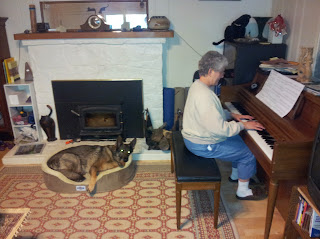 |
| Hanging out |
When she came to live with us, our retired seeing eye dog,
Tajji, had on on/off switch. “On” meant working on a rigid guide harness,
focusing on all the things she had been taught to do for her blind handler, to
the exclusion of all else. Guide work is enormously demanding for the dog, both
physically and mentally. The dog must learn many behaviors (such as looking
both ways when passing through a door or stepping off a curb into a street) and
must perform them reliably. In addition, she must be strong enough to
physically pull her person out of harm’s way. “Off” meant “no holds barred,
completely off duty.” According to her former owner, this included pulling hard
on the leash, playing “keep away,” jumping up on people, and barking and
lunging at other dogs. We very soon witnessed all of these behaviors, all of
them unacceptable in a companion animal. Now Tajji must learn a new set of
behaviors: “normal manners.”
One of life’s joys is taking your dog for a walk. It’s not
only good exercise, it’s a conversation between you. Even if you’re walking and
talking with a human friend, you and the dog can be in communication. When we
looked at Tajji’s challenges, we saw several distinct behaviors to work on.
- Walking on a loose leash, both beside the human handler and
at a distance, depending on the length of the leash.
- Enjoying the banquet of smells, but coming back to heel readily
when called.
- “Checking in” with the handler.
- Walking calmly past other dogs and humans; approaching them
only when released to do so. Greeting humans in a calm way.
Dog-reactivity is a big chunk, so we’re working on that
separately. First, we needed to get Tajji solid with the first three skills.
She already had the foundational skills of Sit, Stay (Wait), and Down, although
her Heel and Come are not reliable when she’s in full-blown “off” mode, so they’ll
need more work.
To help Tajji learn not to pull, we decided to never attach
a leash to her flat leather collar. Previously, that’s the setup in which she
pulled strongly, so we don’t want to replicate those conditions. Dogs have a
reflex to push against any pressure on neck or chest, so a flat collar (or even
a choke chain, which we do not use on our dogs) gives them that signal.
Instead, we chose a front-clip harness. This is a soft nylon webbing harness,
so it’s not like the rigid leather guide harness, and it has a clip in the
center of the chest strap. When the dog pulls, she is turned toward the side of
the leash. This often breaks her focus on whatever it is she is moving toward,
as well as restraining her in a humane way.
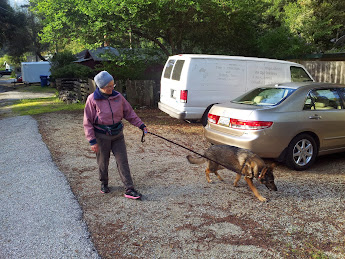 |
| Go Sniff |
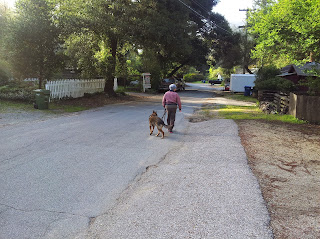 |
| Coming back to Heel |
Tajji quickly adapted to the harness, which stopped almost
all of the pulling (except in the presence of other dogs). We then used
clicker-training to reward walking close to us or coming back to Heel when
called. Because we live in a semi-rural setting and there are so many wonderful
things to smell (traces of other dogs, wild animals), we don’t want to keep her
in strict Heel position all the time – we want her to have fun on the walks! At
first, she was hesitant to leave the side of her handler, undoubtedly a holdover
from her previous work training and having lived in an apartment in a small
city. So we encouraged her to Go Sniff. This skill has the added advantage that
sniffing the ground is a calming behavior for dogs and we’ll be able to use it
as a relaxation technique when we work on Tajji’s dog reactivity.
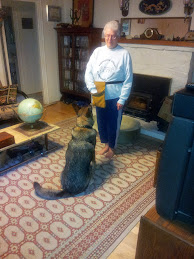 |
| Practicing Look |
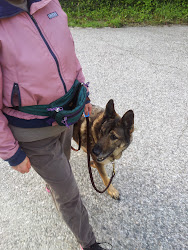 |
| Check In, loose leash |
Checking in is a variation on Look, one of the things we
teach all our dogs. It’s a way of asking the dog to pay attention to us. Eye
contact isn’t natural for dogs, the way it is for people, so we practiced it
with the clicker and treats indoors, where there are fewer distractions. Once
she learned the command Look, we were able to practice it outside (click/treat)
and then to click/treat when the behavior is offered without the command. All
the while telling her what a good job she’s doing, of course.
Now we have the foundations for a pleasant walk with a dog
who keeps in touch with us while “enjoying the scenery” within the length of
the leash.



